Oh boy, it’s already winter again. We all know what that means, don’t we? It’s time for some ice fishing action!
This is a really awesome aspect of the sport, but it’s also more dangerous than regular fishing. Because if you go through that ice, it can be game over.
Every year you can read about some guys drowning or freezing to death because they went out on ice that was too thin. It’s always a terrible thing to read about, to be honest.
That’s why I decided to write up this little article. I’ve been ice fishing for over 20 years now and have only gone through once.
Luckily, that was on a very shallow lake, and I could get out without a problem. But man, was I scared after that! Never underestimate the ice, and always have respect for it!
I also checked various ice fishing groups on Facebook and asked anglers for their best safety tips on the ice. This made the article way more helpful and valuable!
So, please read the following tips and remember them when you head out. They might save your life one day!
Tip #1: Always check ice thickness
The first and most important thing is always to check the thickness of the ice!
Generally speaking, you should stay off ice that’s less than 4 inches thick. PERIOD!
Personally, I prefer 6 inches, just in case, but 4 will generally do, though. However, you must check the ice on your way out constantly.
4 inches of ice can quickly turn into 3 or 2 inches. And boom, you’re going through!
Please keep that in mind, especially when it comes to first ice. I know the urge to head out there for the first time is strong, but that first ice fishing trip surely isn’t worth your life, is it?
The Minnesota DNR has good guidelines for new ice thickness. But remember: no matter how solid or thick it might be, no ice is 100% safe!
Ice thickness guidelines for new, clear ice
| Under 4″ | Stay off! |
| 4″ | Ice fishing or other activities on foot |
| 5″ – 7″ | Snowmobile or small ATV |
| 7” – 8” | Side-by-side ATV |
| 9” – 10” | Small car or SUV |
| 11” – 12” | Medium SUV or small truck |
| 13”- 15” | Medium truck |
| 16” – 17” | Heavy-duty truck |
| 20”+ | Heavy-duty truck with wheelhouse shelter |
Here are some excellent quotes from ice anglers sharing their wisdom on Facebook:
Be very cautious on ice with snow on it. Snow insulates and can hide thin ice.
Brian Stewart
If there’s less than 4″ of ice, stay home and charge batteries, respool reels, sharpen fillet knives, etc.
Washburn Gitchigumi
Don’t be impatient!
Daryle Kaskiw
Just cause you got on the 1st time doesnt mean it is safe the next time, when we have (warm) weather like this.
Douglas Pries
Tip #2: Trust your spud bar
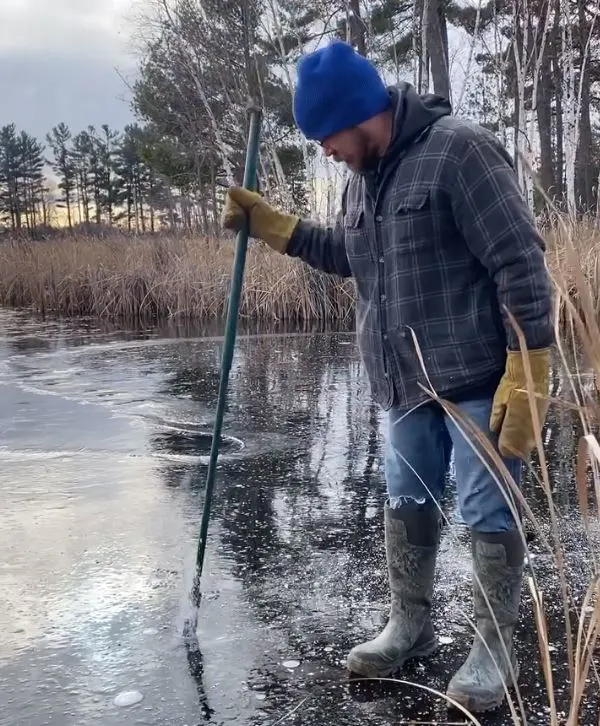
A spud bar or ice chisel is probably your most important tool on the ice! It’ll help you check the thickness and compactness of the ice.
Personally, I wouldn’t head out without one. It’s really vital!
A spud bar allows you to test the ice quickly and frequently, saving you time and energy, as you won’t have to drill dozens of holes with your auger.
For thinner ice, between 4 and 6 inches, you can even use it to make your holes. This way, you skip carrying around that heavy ice auger and build some extra muscle.
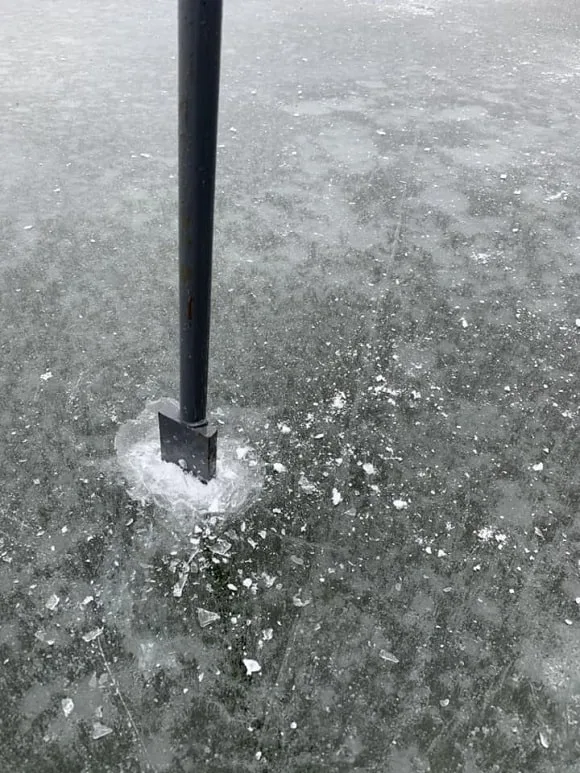
Here are a few valuable quotes from other ice anglers on Facebook:
People should spud-step-spud. Use a spud bar always when going on thin ice!
Tom Judd
Spud your way out. Test frequently.
Eric Olson
One or two hits with your heavy spud bar,in the same exact spot, the ice is usually 2 inches thick. 4 or more hits in the same spot, its usually about 4 inches of ice and you should be able to fish it.
Tommy Rudack
Tip #3: Always wear ice picks
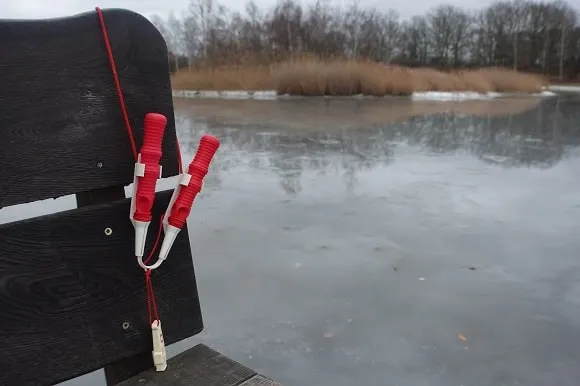
Never go on the ice without wearing that good old trusted pair of ice picks around your neck!
If, God forbid, you should fall through, these things can end up saving your life!
Without them, you might never be able to pull yourself out of the water and onto the ice.
So please don’t take them off while ice fishing. That’s not the point of bringing them!
There’s also an important psychological aspect to consider here, as ice picks can give you peace of mind by simply wearing them.
Here’s what some of the ice anglers on Facebook have to say about ice picks:
I’ve gone through when there was no snow on the ice, impossible to get back on top when water from falling through gets on the surface. Ice Picks were the difference that day.
Greg Eaton
Make sure your ice picks are quickly available!
Sean Thurman
Tip #4: Don’t go ice fishing alone
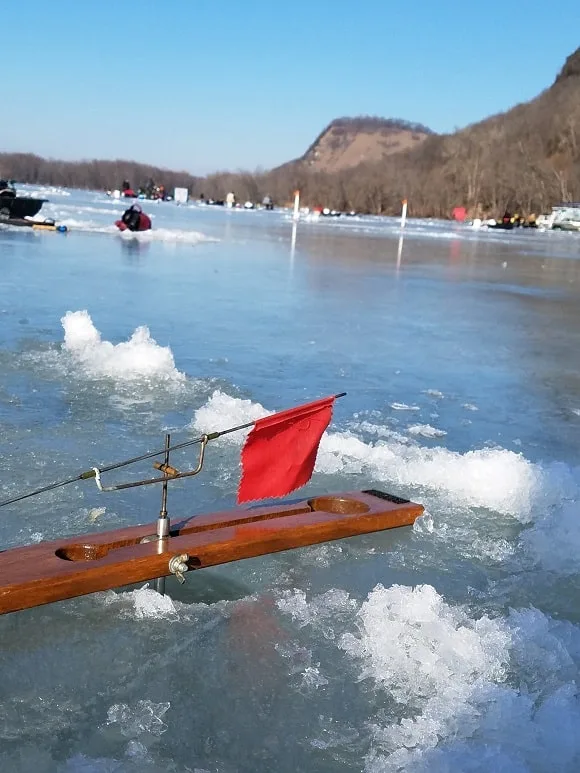
This is a great safety tip for early ice that you might be uncertain about.
The buddy system can ensure that your friend or friends can help you in case of an emergency or that you can help your friend or friends!
Making your way back onto the ice alone can sometimes be an impossibility. Having someone around who could help you or quickly get help can make all the difference!
Besides, it’s always more fun to go fishing together with your buddies.
Here are some great quotes from other ice anglers:
Number one! Always go out with someone.
Kevin Locke
On first ice, less than 4″, don’t stand around in a crowd!
Thomas H Pospiech Sr
Tip #5: Wear a float suit or life jacket
Here is what some of the other ice anglers on Facebook had to say:
Float suits are expensive till you need them (then they are priceless).
Patrick Hagemeier
Float suit! I learned the hard way!
Ken Melland
Tip #6: Bring a throw rope
Another essential thing you should take with you when heading out onto the ice.
A thicker rope can save lives in several ways!
1) Your buddy can throw you that rope and pull you out from a safe distance.
2) You can do the same thing for your buddy.
3) If possible, you can throw it toward your buddy after falling through so that he can pull you out.
Here are a few more tips from some of the other ice anglers on Facebook:
I always carry a 30ft section of 1/2″ rope with me.
Mike Bennwitz
I carry a rope and boat cushion. Might be able to help someone else.
Bob Bowden
Tip #7: Know your lake
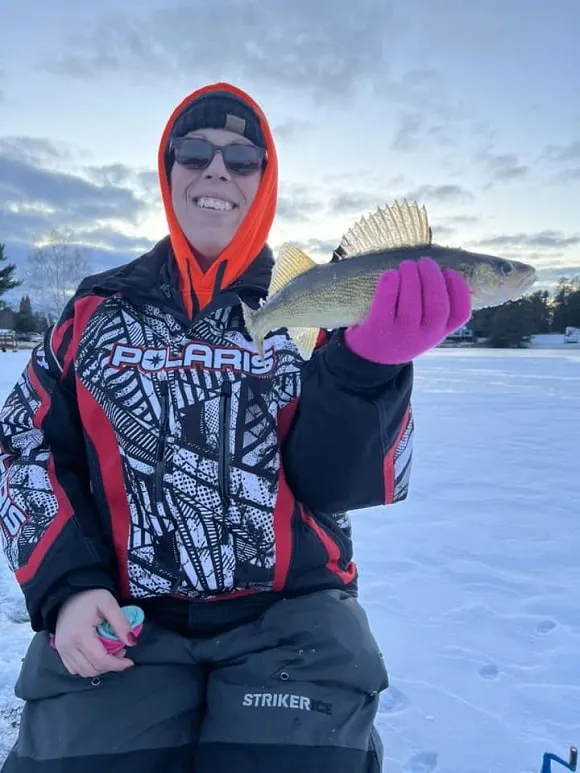
Of course, this isn’t a guarantee for safe ice or that you won’t go through, but knowing the lake you’re ice fishing on can make a lot of difference.
It certainly helps if you know the depth structure of your lake, where the shallow and deep areas are located.
Additionally, if possible, you should also be aware of currents, springs, drifts, inlets, outlets, bridges, docks, etc.
Basically, anything that could weaken the ice or make it thinner!
I remember a lake with a warm water inlet from a nearby power plant. The ice around that inlet was always very thin, and many were unaware of its existence. It was a very dangerous spot, and many went through there.
Here are some excellent tips from other ice anglers:
Only go during daylight hours so you can see active springs and spud around them.
Brad Kenney
My safest ice advice is 1” of ice for every foot of water depth. So if you fall through 4” of ice, you’re only in 4′ of water.
Joshua Floyd Popour
My advice is stay under 4 or 5 ft deep water if you don’t know the lake.
Blake Chase
Tip #8: Tell people where you are going
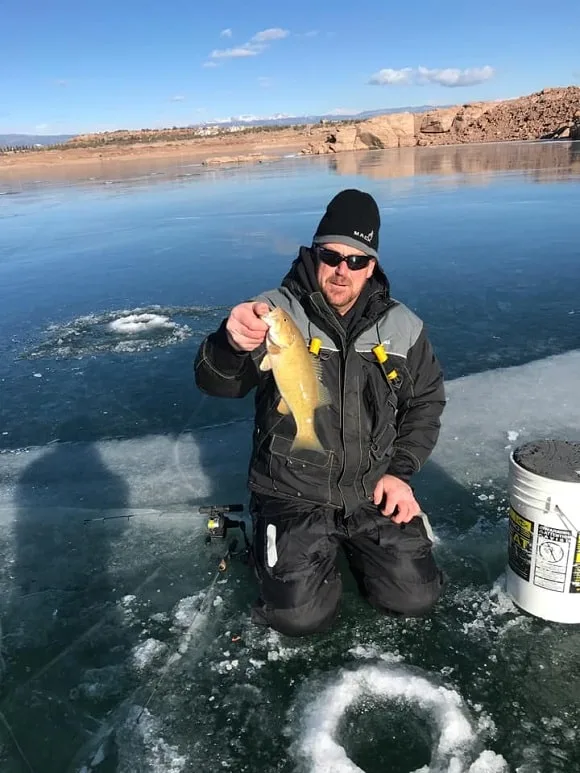
This is an obvious but critical point. Always tell other people where and when you are going and when they should expect you back!
Tell your mom, partner, kids, buddies, neighbor, or anyone else who can quickly sound the alarm bells if you don’t respond to calls or don’t get back home on time.
Just make sure you let people know where you are when you’re going ice fishing.
Another great tip is to always carry a cell phone with you (although who doesn’t nowadays…) so people can locate you digitally.
Here are some quotes from some of the ice anglers on Facebook:
I always tell my location to my family and how long I’m gonna go. And I always text them a report of what is happening.
Nigel Thao
I make sure to tell someone where I’m going and about what time i should be back if I’m going out alone!
Travis Bird
Tip #9: Be prepared
This is perhaps the most important thing to master if you fall through. You can have the best equipment on earth, but if you panic and don’t remain calm, none of that will save you!
You must prepare yourself mentally for the unthinkable! Because if you go through, remaining calm and focused is key to your survival.
Unfortunately, the best way of preparing your body and mind for an event like that is to simulate!
Try falling through thin ice on purpose (with all the safety gear and a few of your friends around, of course), and then train yourself to get back onto the ice calmly and focused.
You’ll be so much more ready for the real deal!
PRO TIP: Your local fire department might have great ice rescue training tips for you! You might even be able to join one of their drills or public instruction courses.
Being prepared for the ice-cold water is only half the job, though. Ensure you bring the proper safety gear and have warm, dry clothing available. Preferably in your car, which you can also use to warm up!
Hypothermia is no joke!
Here are a few constructive ice rescue tips from other ice anglers for you:
Situational awareness. Be honest with your equipment, experience, and physical ability.
Rich Handrick
Keep blankets, a garbage bag, and fire starter in the truck. If you go through and get out you still aren’t safe hypothermia will kill you if you don’t get dry and warm fast.
Jonathon Dausey
Always where ice cleats. A lot more people get hurt from falling and hitting their head than you would falling through.
Issac Saffert
I really hope you found this article useful and helpful and that the tips will help you get knowledge and awareness about ice safety.
Please always put your health and life first! No fish is worth dying for!
Use common sense and just stay off the ice if things don’t feel right. Trust your gut feeling, it usually never let’s us down.
And remember: no magtter how thick the ice and how much research you’ve done, THERE IS NO 100% SAFE ICE. EVER!
Happy ice fishing and stay safe out there!


Leave a comment